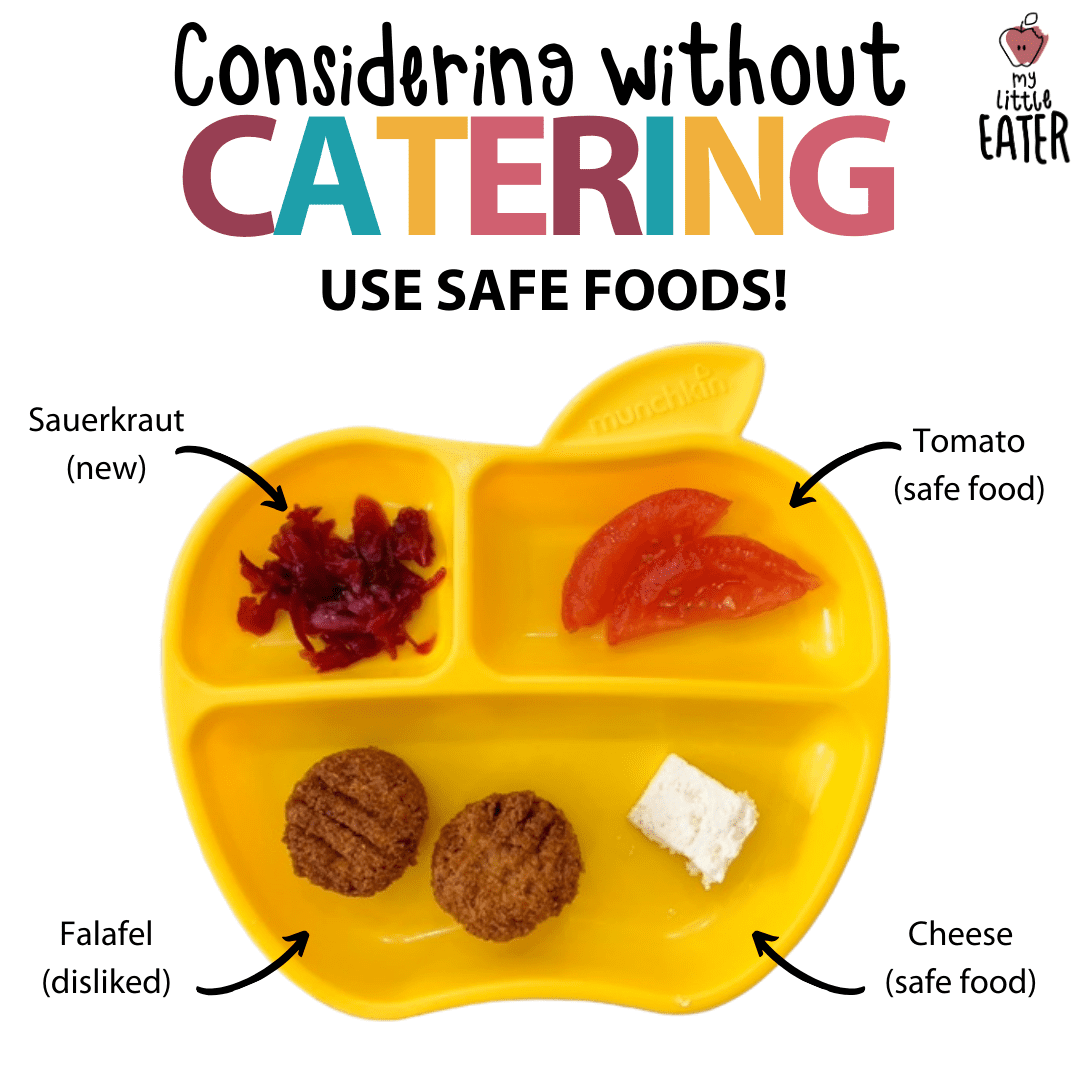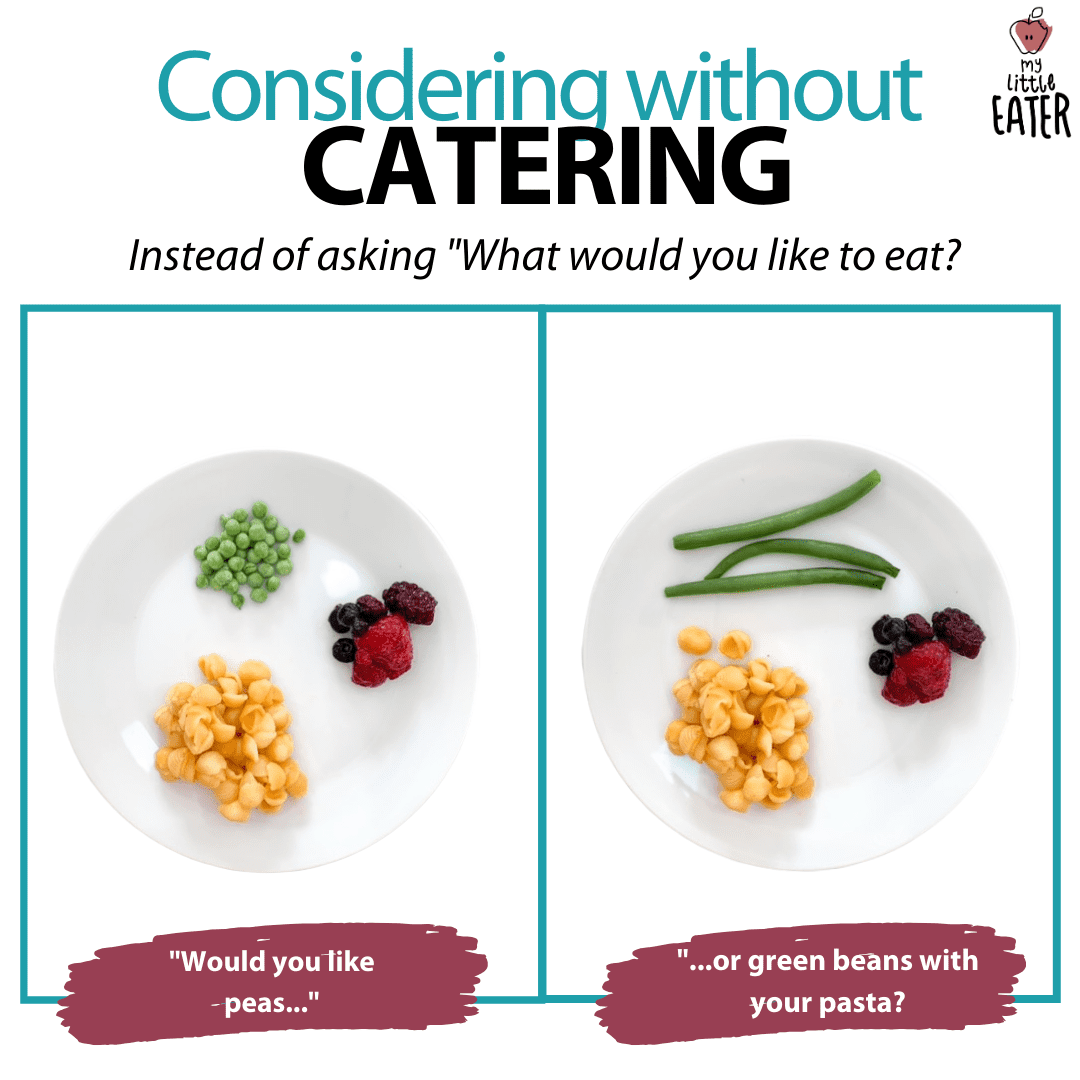![Main image for the article [How to Avoid Catering Meals]. Pictured is toddler eating strawberries and plums.](https://mylittleeater.com/wp-content/uploads/2020/02/New-Blog-Post-Image-Size-1-2-300x300.png)
Parents ask me all the time what my thoughts are on offering their baby/toddler an alternative meal if they refuse the first choice. Is it bad? Is it okay under certain circumstances? What if it’s the only way to get their child to eat?
This is a topic that I feel quite strongly about, as a result of both personal experiences with my own children and from what the research says on the topic. As a parent myself, I fully understand the fear many of us have that our child will go hungry if we don’t offer an alternative, or a back up meal. We also all want to give them more autonomy over meal choices so they do not feel as though they have no say in the matter. And so, we give our babies and toddlers the power to refuse a meal we’ve offered in favour of another one of their liking.
However, I think as parents we need to step back and look at approaching how we let our kids dictate what’s served at mealtimes much like we would approach letting them choose their own bedtime, or their itinerary for the day, or whether or not to wear a life-jacket when swimming. If we let them choose such things without any structure or guidance, we might face a chronically overtired child who doesn’t know how much sleep is good for them, or a child who wants to sit in front of the TV all day, or one that risks their own safety in the water.
In much the same way, we don’t want our child to have free reign in choosing what to eat with little to no boundaries set on what they can choose from. When we give in and offer an alternative meal out of fear that they won’t eat, or because they threw enough of a fit, we’re:
- Giving up our control around our role in feeding (which causes mealtime battles)
- Increasing picky eating (they get stuck eating the same foods)
- Risking poor nutrition (they won’t be eating well rounded, nutritious foods)
Without an alternative meal option, a few things will start to happen. First, children will try over time to taste the food you’ve offered, especially when hungry, as they know there won’t be another choice. They won’t hold out for another, more appealing food because they know they won’t be able to get it (i.e.no power struggle). Second, it will prevent them from getting into a food rut, because they won’t continually fall back to the same tried and true foods. Instead, they will be required to eat from a variety of meals, which over time will expand their palates and boost their nutrition. Third, you won’t be making separate meals for them, because let’s be honest, no one has time for that!
I’ve spoken before about the roles and responsibilities for both child and parent when it comes to feeding…aka the division of responsibility. If you haven’t checked it out, definitely go ahead and do that first right here before reading on.
Here’s a summary of how it goes:
The role of the parent is to choose:
- What meal you are going to offer
- Where it will be eaten
- When it will be eaten
The role of the child is to choose:
- If and what they want to eat from what you’ve offered them
- How much they want to eat
With this method, immediate boundaries are set to allow for clear roles between parent and child. This eliminates a power struggle between child and parent, and keeps a healthy and trusting feeding relationship going, which is needed to raise a healthy eater.
Within this framework we can see that it’s our job as parents to provide children with healthy and nutritious meals. This is the structure we can give them. However, it is normal, and even expected, that children may not want to eat every meal the way you’ve chosen to serve it.
So, I’m going to give you some concrete strategies to set up the experience as positively as possible to make both parties happy…a way to be considerate without actually catering to them.
Always offer a safe food
Probably the biggest tip I have to ensure you are being considerate without catering, and that your baby/toddler never leaves the table truly hungry, is to always include a safe food for them at mealtimes.
A safe food is a food that you know they’ll readily accept…something you know that most of the time they will reasonably eat if they’re hungry. When they come to the table and see this safe food, it will reduce their stress and reassures them that there is at least one thing they can eat.
Usually, this is something like bread, fruit, crackers, rice, cheese, or noodles…but that doesn’t mean it can’t be a veggie or meat you know they eat! This is considerate and respectful to their preferences and abilities. It offers a solution so that you’re not offering them a completely separate meal from the rest of the family…the meal is one and the same! You’re telling them there is no “your food” and “my food”…it’s one family meal, where they can also feel confident that there is something they will be able to eat.
Now, a lot of times people will tell me: “Well, my toddler’s just going to eat bread all day. If that’s their safe food, they will only choose that and bypass everything else.”
I get that…and it likely will happen some of the time, especially as they’re learning to adapt to these new meal formats.
What you want to do is switch up that safe food so it’s not the same one every time. So maybe if bread is a safe food for them, you don’t offer it every single time, meal after meal, or night after night.

Remember…a safe food doesn’t have to be an absolute favourite food! It could just be a food that has been mostly accepted previously. So make sure you’re switching it up! Maybe cheese one day, or even milk another. In this blog post, I show you how you should not only rotate new foods, but also rotate safe foods, and change properties little by little so that they’re not always getting stuck on the same thing.
Make a meal plan that incorporates everyone’s favourites
Sometimes we unintentionally pick meals that we know our toddlers will eat when we’re meal planning. We might think “I know he’ll eat nuggets and fries…so I’ll make that on Monday. And I know he’ll eat pasta, so I’ll make that Tuesday”. What happens is we’re basically catering to our baby or toddler without them necessarily having to ask us! Or…we’re asking them, “What do you want for dinner?” and then we’re stuck preparing only the foods they ask for.
This once again narrows down the number of foods they’re exposed to, increases picky eating, and teaches them that their opinions and preferences around food are more important than everyone else’s in the family.
So I want you to ask yourself deliberately, “What is something that I want to have for dinner?” Then go ahead and put it down in your meal plan and start including it in the rotation. In fact, go ahead and rotate every family member’s favourite dish, so they all have a say and teach your baby/toddler to learn that we respect everyone’s preferences…not just theirs! Meals will not always be catered to them outside of the home, nor should they be. Getting them used to learning how to cope and manage eating amongst the choices offered to them within any meal is something to get them used to!
Now, it’s still okay to take your child’s preferences into account even when it’s not their choice for a meal – in fact, it’s respectful! If they ask for something ahead of time, you get to decide if and when it makes sense to include it in your meal plan rotation. If they ask for something during mealtime that is not on the menu, you can say “That sounds great! We can put that on the menu for this weekend. Tonight we’re having xyz”
Give them structured choice
If they’re a bit older and you’d like to give them a bit more autonomy over the process, you can definitely achieve this by incorporating what I like to call “structured choice”. In other words, you really DO want your child to exert autonomy and personal preference over their meal by giving them extra choice within the structure you’ve laid out for them.
Here is an example of what this could look like:
Parent: “We are having spaghetti and meatballs with salad tonight. Do you want sauce on your spaghetti noodles, on the side, or no sauce at all?”
Child: “I don’t want any sauce“
Your child now immediately feels like they have some choice in the matter of how they want to eat their meal. Maybe eating the noodles dry isn’t how you’d prefer them to eat it, but as a parent, here is where you’ll need to let go of the control and pass the choice onto your child. You provide the structure, and they choose from within that. If they say that they don’t want either of the options and would rather have something else, you can redirect them to the fact that they can modify the meal how they like, but that this is the only meal you have prepared and the only meal available that night. You can even just say “You don’t have to eat it” and leave it at that. Whatever you do, don’t get sucked into negotiations!

Another example could be:
Parent: “Would you like peas or green beans for your vegetable with dinner?”
Your child might answer (or indicate using body language) by saying that they want the peas, or maybe again, by choosing no vegetables at all. You’ve done your job by offering and they’ve done their job by choosing within that offer.
There is no bargaining or negotiating for another meal that they want to choose. They’ll begin to realize after some time that these rules are consistent, and will come to expect that they can’t make alternative demands.
The more a child sees that you have the role of choosing the meal and they have the role of deciding what and if to eat from it, the easier meal time will get because of the expectations you’ve set. I promise!
If you’re struggling with battles at the dinner table, unsure of what to say, find yourself giving into your child’s demands, or their likes/dislikes, and are worried about their nutrition, my online courses will help you! I’ve got everything you need to know about what and how to feed toddlers in order to raise healthy eaters and overcome picky eating in my Feeding Toddlers online course. You can eliminate mealtime battles, and stress, in a matter of weeks while confidently serving nutritious foods and turn picky eating around!





